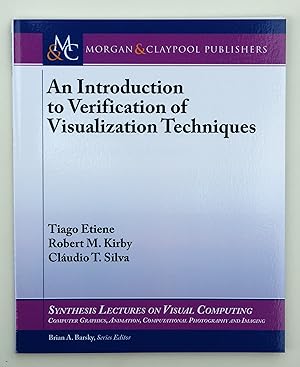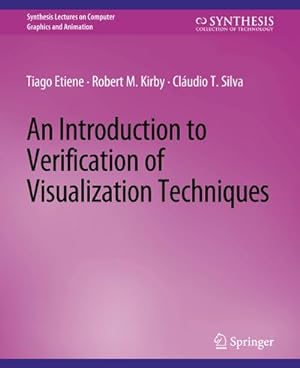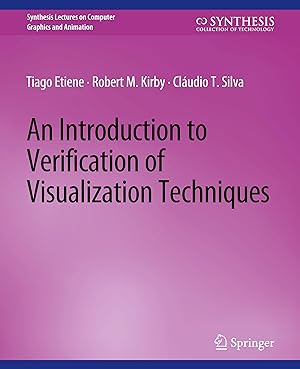Introduction Verification Visualization Techniques by Etiene Tiago (12 results)
Search filters
Product Type
- All Product Types
- Books (12)
- Magazines & Periodicals (No further results match this refinement)
- Comics (No further results match this refinement)
- Sheet Music (No further results match this refinement)
- Art, Prints & Posters (No further results match this refinement)
- Photographs (No further results match this refinement)
- Maps (No further results match this refinement)
- Manuscripts & Paper Collectibles (No further results match this refinement)
Condition Learn more
- New (11)
- As New, Fine or Near Fine (1)
- Very Good or Good (No further results match this refinement)
- Fair or Poor (No further results match this refinement)
- As Described (No further results match this refinement)
Binding
- All Bindings
- Hardcover (No further results match this refinement)
- Softcover (12)
Collectible Attributes
- First Edition (No further results match this refinement)
- Signed (No further results match this refinement)
- Dust Jacket (No further results match this refinement)
- Seller-Supplied Images (6)
- Not Print on Demand (7)
Language (1)
Price
- Any Price
- Under US$ 25 (No further results match this refinement)
- US$ 25 to US$ 50
- Over US$ 50
Free Shipping
- Free Shipping to U.S.A. (No further results match this refinement)
Seller Location
Seller Rating
-
Condition: New. 1st edition NO-PA16APR2015-KAP.
-
An Introduction to Verification of Visualization Techniques (Synthesis Lectures on Visual Computing: Computer Graphics, Animation, Computational Photography and Imaging)
Seller: Ria Christie Collections, Uxbridge, United Kingdom
US$ 38.48
US$ 15.99 shipping
Ships from United Kingdom to U.S.A.Quantity: Over 20 available
Add to basketCondition: New. In English.
-
An Introduction to Verification of Visualization Techniques
Seller: Chiron Media, Wallingford, United Kingdom
US$ 36.40
US$ 20.68 shipping
Ships from United Kingdom to U.S.A.Quantity: 10 available
Add to basketPF. Condition: New.
-
An Introduction to Verification of Visualization Techniques (Synthesis Lectures on Visual Computing: Computer Graphics, Animation, Computational Photography and Imaging)
Published by Morgan & Claypool Publishers, 2015
ISBN 10: 1627058338 ISBN 13: 9781627058339
Language: English
Seller: Our Kind Of Books, Liphook, United Kingdom
US$ 41.25
US$ 29.57 shipping
Ships from United Kingdom to U.S.A.Quantity: 1 available
Add to basketSoft cover. Condition: As New. This book has been in storage since publication and is unread. Hence the description as new .
-
An Introduction to Verification of Visualization Techniques
Published by Springer International Publishing, 2015
ISBN 10: 3031014596 ISBN 13: 9783031014598
Language: English
Seller: AHA-BUCH GmbH, Einbeck, Germany
Taschenbuch. Condition: Neu. Druck auf Anfrage Neuware - Printed after ordering - As we increase our reliance on computer-generated information, often using it as part of our decision-making process, we must devise tools to assess the correctness of that information. Consider, for example, software embedded on vehicles, used for simulating aircraft performance, or used in medical imaging. In those cases, software correctness is of paramount importance as there's little room for error. Software verification is one of the tools available to attain such goals. Verification is a well known and widely studied subfield of computer science and computational science and the goal is to help us increase confidence in the software implementation by verifying that the software does what it is supposed to do. The goal of this book is to introduce the reader to software verification in the context of visualization. In the same way we became more dependent on commercial software, we have also increased our reliance on visualization software. The reason is simple: visualization isthe lens through which users can understand complex data, and as such it must be verified. The explosion in our ability to amass data requires tools not only to store and analyze data, but also to visualize it. This book is comprised of six chapters. After an introduction to the goals of the book, we present a brief description of both worlds of visualization (Chapter 2) and verification (Chapter 3). We then proceed to illustrate the main steps of the verification pipeline for visualization algorithms. We focus on two classic volume visualization techniques, namely, Isosurface Extraction (Chapter 4) and Direct Volume Rendering (Chapter 5). We explain how to verify implementations of those techniques and report the latest results in the field of verification of visualization techniques. The last chapter concludes the book and highlights new research topics for the future.
-
Taschenbuch. Condition: Neu. An Introduction to Verification of Visualization Techniques | Tiago Etiene (u. a.) | Taschenbuch | xii | Englisch | 2015 | Springer | EAN 9783031014598 | Verantwortliche Person für die EU: Springer Verlag GmbH, Tiergartenstr. 17, 69121 Heidelberg, juergen[dot]hartmann[at]springer[dot]com | Anbieter: preigu.
-
Condition: New. Print on Demand.
-
An Introduction to Verification of Visualization Techniques (Synthesis Lectures on Visual Computing: Computer Graphics, Animation, Computational Photography and Imaging)
Seller: Biblios, Frankfurt am main, HESSE, Germany
Condition: New. PRINT ON DEMAND.
-
An Introduction to Verification of Visualization Techniques
Published by Springer International Publishing Dez 2015, 2015
ISBN 10: 3031014596 ISBN 13: 9783031014598
Language: English
Seller: BuchWeltWeit Ludwig Meier e.K., Bergisch Gladbach, Germany
Taschenbuch. Condition: Neu. This item is printed on demand - it takes 3-4 days longer - Neuware -As we increase our reliance on computer-generated information, often using it as part of our decision-making process, we must devise tools to assess the correctness of that information. Consider, for example, software embedded on vehicles, used for simulating aircraft performance, or used in medical imaging. In those cases, software correctness is of paramount importance as there's little room for error. Software verification is one of the tools available to attain such goals. Verification is a well known and widely studied subfield of computer science and computational science and the goal is to help us increase confidence in the software implementation by verifying that the software does what it is supposed to do. The goal of this book is to introduce the reader to software verification in the context of visualization. In the same way we became more dependent on commercial software, we have also increased our reliance on visualization software. The reason is simple: visualization is the lens through which users can understand complex data, and as such it must be verified. The explosion in our ability to amass data requires tools not only to store and analyze data, but also to visualize it. This book is comprised of six chapters. After an introduction to the goals of the book, we present a brief description of both worlds of visualization (Chapter 2) and verification (Chapter 3). We then proceed to illustrate the main steps of the verification pipeline for visualization algorithms. We focus on two classic volume visualization techniques, namely, Isosurface Extraction (Chapter 4) and Direct Volume Rendering (Chapter 5). We explain how to verify implementations of those techniques and report the latest results in the field of verification of visualization techniques. The last chapter concludes the book and highlights new research topics for the future. 96 pp. Englisch.
-
An Introduction to Verification of Visualization Techniques
Published by Springer, Berlin|Springer International Publishing|Morgan & Claypool|Springer, 2015
ISBN 10: 3031014596 ISBN 13: 9783031014598
Language: English
Seller: moluna, Greven, Germany
Condition: New. Dieser Artikel ist ein Print on Demand Artikel und wird nach Ihrer Bestellung fuer Sie gedruckt. As we increase our reliance on computer-generated information, often using it as part of our decision-making process, we must devise tools to assess the correctness of that information. Consider, for example, software embedded on vehicles, used for simulati.
-
An Introduction to Verification of Visualization Techniques
Published by Springer, Springer International Publishing Dez 2015, 2015
ISBN 10: 3031014596 ISBN 13: 9783031014598
Language: English
Seller: buchversandmimpf2000, Emtmannsberg, BAYE, Germany
Taschenbuch. Condition: Neu. This item is printed on demand - Print on Demand Titel. Neuware -As we increase our reliance on computer-generated information, often using it as part of our decision-making process, we must devise tools to assess the correctness of that information. Consider, for example, software embedded on vehicles, used for simulating aircraft performance, or used in medical imaging. In those cases, software correctness is of paramount importance as there's little room for error. Software verification is one of the tools available to attain such goals. Verification is a well known and widely studied subfield of computer science and computational science and the goal is to help us increase confidence in the software implementation by verifying that the software does what it is supposed to do. The goal of this book is to introduce the reader to software verification in the context of visualization. In the same way we became more dependent on commercial software, we have also increased our reliance on visualization software. The reason is simple: visualization isthe lens through which users can understand complex data, and as such it must be verified. The explosion in our ability to amass data requires tools not only to store and analyze data, but also to visualize it. This book is comprised of six chapters. After an introduction to the goals of the book, we present a brief description of both worlds of visualization (Chapter 2) and verification (Chapter 3). We then proceed to illustrate the main steps of the verification pipeline for visualization algorithms. We focus on two classic volume visualization techniques, namely, Isosurface Extraction (Chapter 4) and Direct Volume Rendering (Chapter 5). We explain how to verify implementations of those techniques and report the latest results in the field of verification of visualization techniques. The last chapter concludes the book and highlights new research topics for the future.Springer-Verlag GmbH, Tiergartenstr. 17, 69121 Heidelberg 96 pp. Englisch.








